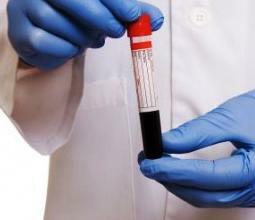 Blood test AST - biochemical blood test, which determines the amount of intracellular enzyme aspartate aminotransferase.
Blood test AST - biochemical blood test, which determines the amount of intracellular enzyme aspartate aminotransferase.
This method of analysis is used to diagnose diseases of the myocardium, the liver and musculoskeletal disorders, it is usually prescribed concomitantly with the analysis of blood ALT, as well as analysis for bilirubin.
The given analysis allows to reveal quantity of a cellular enzyme of ACT in tissues of a liver, kidneys, heart, skeletal musculature, nervous system and other organs. If the analysis of the blood decoding of ACT shows a high amount of aspartate aminotransferase in the tissues of the body, this allows you to draw conclusions about the presence of violations in this or that organ.
Norm
The AST content in blooddepends on the patient's sex:
- in women, the indicator is within 31 U / l;
- for men, the normal figure is up to 41 U / l;
- in newborns, the norm is 25 to 75 U / l;
- in children aged one to eighteen years - 15 to 60 U / l.
As can be seen, the activity of aspartate aminotransferase in the body of a woman is slightly lower than in the male body, and in children it is higher than in adults.
Indications for the purpose of the assay
The AST blood test is necessary for the precise determination of the intracellular enzyme aspartate aminotransferase, which is detected as a result of biochemical analysis.
Assignit in the following cases:
- All pathologies of the liver.
- All kinds of jaundice and bilirubin exchange disorders.
- Autoimmune diseases.
- Endocrine diseases.
- Infections.
- Intoxication.
- Malignant tumors.
- Skin diseases of an allergic nature.
- Long-term treatment with antibiotics, chemotherapy and various toxic drugs.
- Diseases of the circulatory system.
- Chronic and acute heart diseases.
- Renal failure.
- Injuries to the abdomen and thorax.
- Preparing for a complex surgical operation.
- Purulent-septic pathology.
- Encephalopathy of unknown etiology.
- Disturbances of outflow of bile, cholelithiasis.
- Pancreatitis is chronic.
- Evaluation of treatment of hepatic and cardiac pathologies
It is important to note that for 7-15 days before blood donation to AST it is necessary to completely exclude taking medications. However, if this can not be done, the doctor, before taking blood, should be advised of the number of drugs and their daily dosage.
Causes of elevated AST
Why is the AST index increased, and what does it mean? In adults, the level of AST increases with diseases accompanied by the disintegration of tissues rich in these enzymes. Excess of AST in 2 - 5 times is considered moderate, in 6-10 times - average, higher indices - significant increase.
More oftenAST is diagnosed above the norm with:
- acute or chronic hepatitis;
- alcohol intoxication;
- development of obstructive jaundice;
- destruction of liver cells;
- dermatomyositis;
- Mesentery infarction;
- infectious mononucleosis;
- progressive muscular dystrophy;
- fatty liver disease;
- local radiation injuries;
- acute pancreatitis;
- necrosis of cardiomyocytes (cardiac muscle cells);
- necrosis or injury to the cells of the muscles of the skeleton;
- poisoning with chloroform, pale toadstool, carbon tetrachloride;
- therapy with hepatotoxic drugs and drugs that cause cholestasis.
The determination of the AST level is often carried out in conjunction with ALT. The availability of data on the level of these two enzymes allows one to assume the localization of the pathological process, its severity and build a prognosis. There is, so-called, the Ratis coefficient - the ratio of AST / ALT. Normally, this figure is 1.33. With heart disease, it increases, and with liver pathology - decreases (with the exception of alcohol damage).
What to do
It should be clearly understood that an increase in AST is not the cause of the disease. This is its consequence. Therefore, only the elimination of the causative disease will be able to interrupt the causal relationship, which will be reflected in the form of normalization of ACT activity and will become the criterion for the victory over this disease.
Any cases of increasing aspartate aminotransferase are the reason for seeking specialized medical care. Behind this innocuous and asymptomatic sign are often hidden severe chronic diseases, which will manifest themselves only after a while.
Since this sign signals the destruction of cells containing this enzyme (heart, liver, muscles), it is necessary to engage in the diagnosis and treatment of diseases of these organs.

How to choose probiotics for the intestine: a list of drugs.

Effective and inexpensive cough syrups for children and adults.

Modern non-steroidal anti-inflammatory drugs.

Review of tablets from the increased pressure of the new generation.
 Antiviral drugs are inexpensive and effective.
Antiviral drugs are inexpensive and effective.



